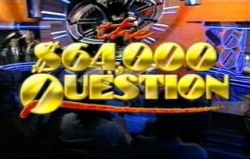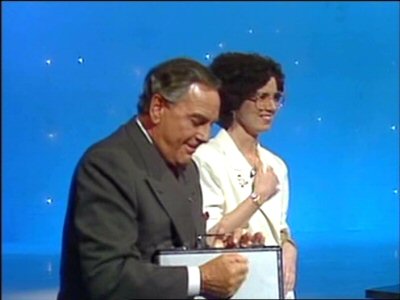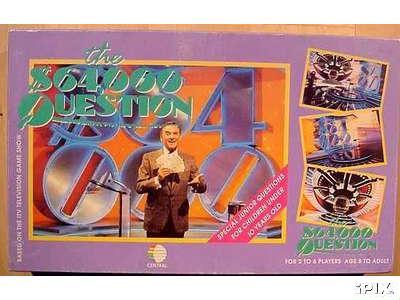The $64,000 Question
Contents |
Host
Jerry Desmond (1956-8)
Robin Bailey (The 64,000 Challenge)
Bob Monkhouse (1990-3)
Co-host
Announcer: Nick Jackson (1990-3)
Broadcast
as The 64,000 Question: ATV, 19 May 1956 to 18 January 1958 (80 episodes in 2 series)
as The 64,000 Challenge: ATV, 15 June 1957 to 31 August 1957 (7 episodes in 1 series)
Central for ITV, 1 June 1990 to 4 September 1993
Synopsis
Early days
A phenomenally successful version of the American original, which ran live every week and helped cement the new ITV's place as Britain's favourite channel.
Contestants would choose a specialist subject, and answer questions of increasing value - a single question on their subject for 100 and 500, a two-part question for 1000 and 2000, three parts for 4000, four for 8000, five parts for 16,000, six for 32,000, and a question of no fewer than seven parts for the 64,000 top prize.
With each contestant returning on up to six shows, audience interest built to a frenzy, or the 1950s equivalent.
In summer 1957, the most successful contestants to date faced The 64,000 Challenge. Members of the public would challenge them head-to-head on their specialist subjects for cash prizes.
Double Your Money...
Gagmeister-in-chief Monkhouse hosted a tensionless but otherwise well-produced update version in the 1990s.
Contestants would choose a specialist subject from which their questions were drawn. The first stage of the game offered £1 for the first question, leading up to questions worth £25, £50, £100, £200 and £400 (the last two of which were two-part questions). If they reached the £400 level, their money would be safe.
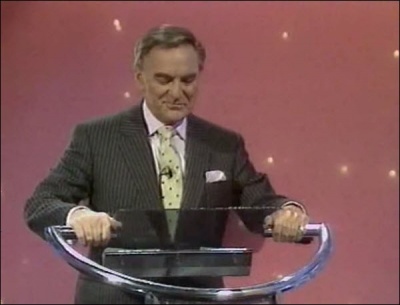 Host Bob Monkhouse and his nifty glass panel of questions
Host Bob Monkhouse and his nifty glass panel of questionsVideo Wall & Isolator
The £800 and £1,600 questions were played at the video wall. The £800 question was in three parts, the £1,600 question was in four parts (and each of the four correct answers would reveal part of a picture via the video wall). The £1,600 milestone was the next safeguard point. In order to earn the "right and obligation" to go for the £3,200 and £6,400 questions, the contestant would have to answer a "key question" which would be related to the picture revealed during the £1,600 question.
For the final two questions, the contestants were placed in a way-over-the-top isolation booth known as "The Isolator" that wouldn't have looked out of place in Encounters of the Third Kind. As the booth entered the studio from above, huge jets of dry ice rained down on to the studio, causing an awful mess to clear up, no doubt.
The £3,200 question was a five-parter, but an extra sixth part would be made available if the contestant was in trouble. (In the second Monkhouse-series, this sixth part was no longer offered, hence the fact that fewer contestants made it to £3,200 - although at least they'd still go away with £1,600). The £6,400 question was a six-parter (with a seventh part in reserve), but unlike the £3,200 question, Bob would read out all six questions in a row before letting the contestant decide whether to answer them straight away, or use ten seconds of thinking time and collect their thoughts. Contestants could also pass, in which case Bob would come back to the question at the end, but before the 'reserve' sixth or seventh part if the contestant had answered a question incorrectly.
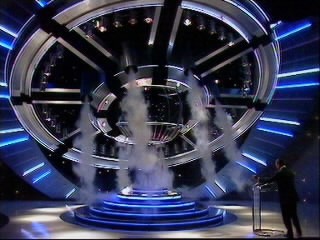 The spaceship/booth affair makes its entrance
The spaceship/booth affair makes its entranceNearly, but not quite
The disappointment of this show was two-fold. Firstly, the top prize was only £6,400, but this is not the fault of the programme makers. At the time, the top prize allowed by the IBA (Independent Broadcasting Authority) for off-peak television programmes was £6,000, and special permission had to be sought to break this slightly. Secondly, players were guaranteed £1,600 even if they failed on the £3,200 or big £6,400 question.
The show was later relegated to a Sunday tea-time slot, but was notable for its slick approach, rather like Monkhouse himself.
Key moments
The outtake where Bob couldn't open the briefcase of money.
The man who took "Geography" as his category and failed on the £1 question which was a 50-50 choice between spring or neap tides.
Bob asking a contestant if she wishes to 'PISS' instead of 'PASS'.
One contestant informed Bob that he (the contestant) had an interest in monasteries. Bob replied (predictably enough), "Well, you should be all right with an old Monkhouse, then!"
Catchphrases
On being asked why they didn't rename the show given that $64,000 dollars wasn't on offer, Bob Monkhouse replied "You don't fool around with successful catchphrases".
A brilliant Monkhouse segue into the commercials: "This is the show that likes to give everyone a break, and here's yours..."
At the beginning of the show: "With TV's biggest cash prize, it's The $64,000 Question - and here's the master of the quiz - Bob Monkhouse!"
"Could I ask you, please, to step into...the Isolator?"
(Once the contestant was inside the Isolator): "Can you hear my voice clearly?" (The usual response was, "Loud and clear, Bob, yes!")
"...Should you fail on any of the six parts, it will bring into play the seventh and final part, which I'm holding in reserve! Should you wish to pass on any of the six parts, please let me know and we can come back to it at the end!"
(After giving the contestant the synopsis of the 6 questions required for the £6,400): "Would you like to dive straight into the questions, or would you like some thinking-time?" (This was usually followed by, "Your ten seconds' thinking time starts...now!" since most contestants wisely opted for the thinking-time).
"You've just won £6,400!"
"Oh, I'm so sorry - that's incorrect!"
Inventor
The original TV format was based on a radio show called Take It or Leave It, which had a top prize of $64. The phrase "sixty-four dollar question" was commonly used in the US during the 1940s to signify a particularly difficult or crucial question; it became the "sixty-four thousand dollar question" shortly after the US television series began in 1955.
Theme music
By Jerry Allen and his TV Trio, who were ATV's house band and also provided the music for Dotto, among other shows.
Ed Welch (1990-3)
Merchandise
Trivia
On the original TV programme, the first person to win the grand prize on TV was Richard McCutchen on the subject of cooking. He had to answer the question "Name and describe five dishes and two wines from the menu of a royal banquet given in 1939 by King George VI of England for French President Albert Lebrun."
The prize for the ATV era was 64,000 sixpences (£1,600), doubling late in 1956 to 64,000 shillings (£3,200).
Actor Bruce Seton, who played the title role of the 1955 ITV drama Fabian of Scotland Yard, was the "Guardian of the Questions" for the ATV era.
Moira Lamb writes:
- My husband, BJK Lamb, was the youngest competitor on the show. He appeared in April 1957 answering questions on Astronomy and was 13 at the time.
During the first Monkhouse series, when winning the £6,400 top prize, a specialised printer was used to print out a personalised cheque which were signed by Bob Monkhouse himself, many years before Chris Tarrant could be seen signing cheques ten times the amount on Who Wants to be a Millionaire? During the second series, this changed to a briefcase of money.
The first two people to win the £6,400 prize were Brian Jones (on the operas of Gilbert and Sullivan) and Kate Vernon-Parry (the works of Beatrix Potter), the first two contestants on the programme. Ms Vernon-Parry had been a Mastermind finalist only a few years before. The last person to win the top amount on the British show was Anthony Holley answering questions on The Rolling Stones.
Bob read the questions from a neat piece of clear glass, which refracted the questions shown from a computer screen in the floor.
Excellent host though Bob undoubtedly was, his habit of both pointedly reminding the contestants how much money they were on the point of winning and keeping them on the hook after they had given their final answers could often prove highly irritating. It was therefore to the considerable credit of many of the contestants that they seemed able to stay cool as cucumbers, even when inside the Isolator - indeed, their friends and relatives in the audience usually looked far more tense!
Pictures
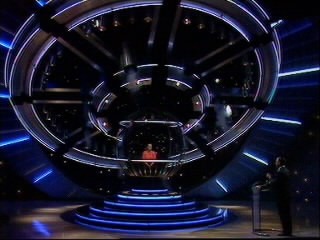 The booth traps its victim.
The booth traps its victim.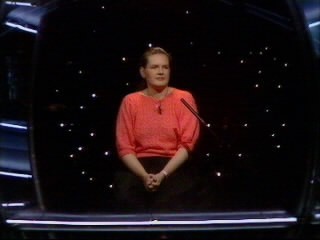 A contestant awaits their $64,000 question in the isolation booth.
A contestant awaits their $64,000 question in the isolation booth.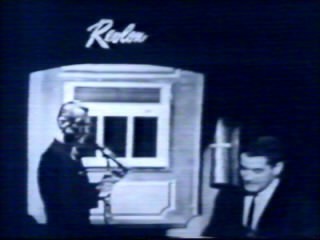 How the original US version looked.
How the original US version looked.Videos
Part 1 of the last episode from Series 2.
See also
Weaver's Week review of a 1991 episode.

